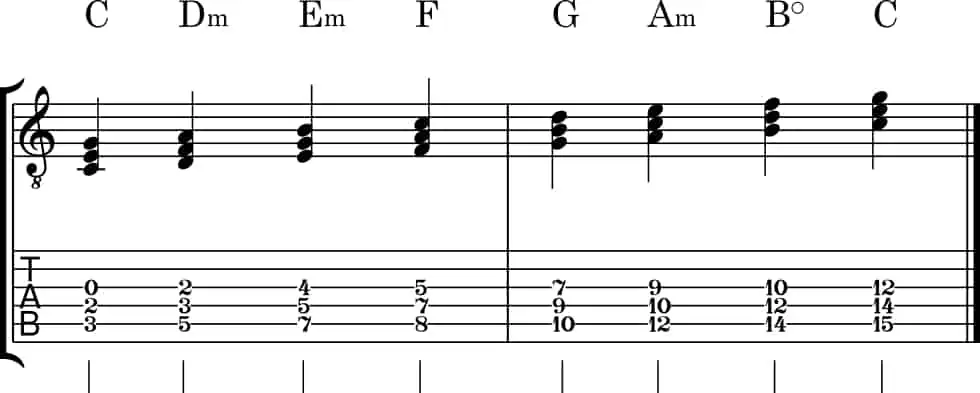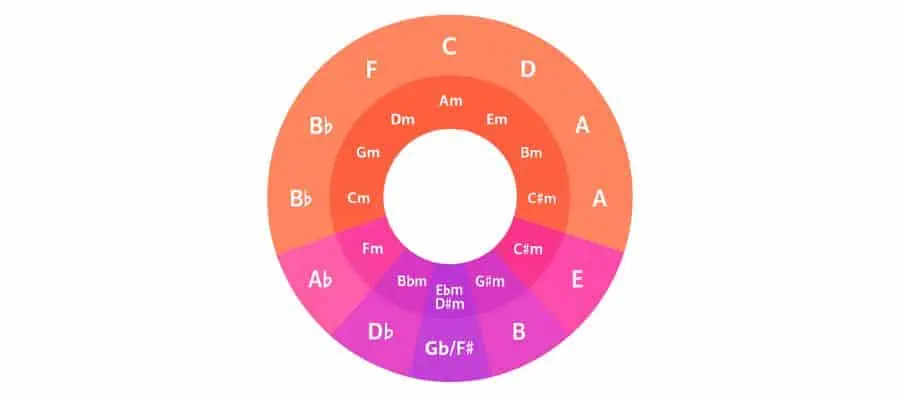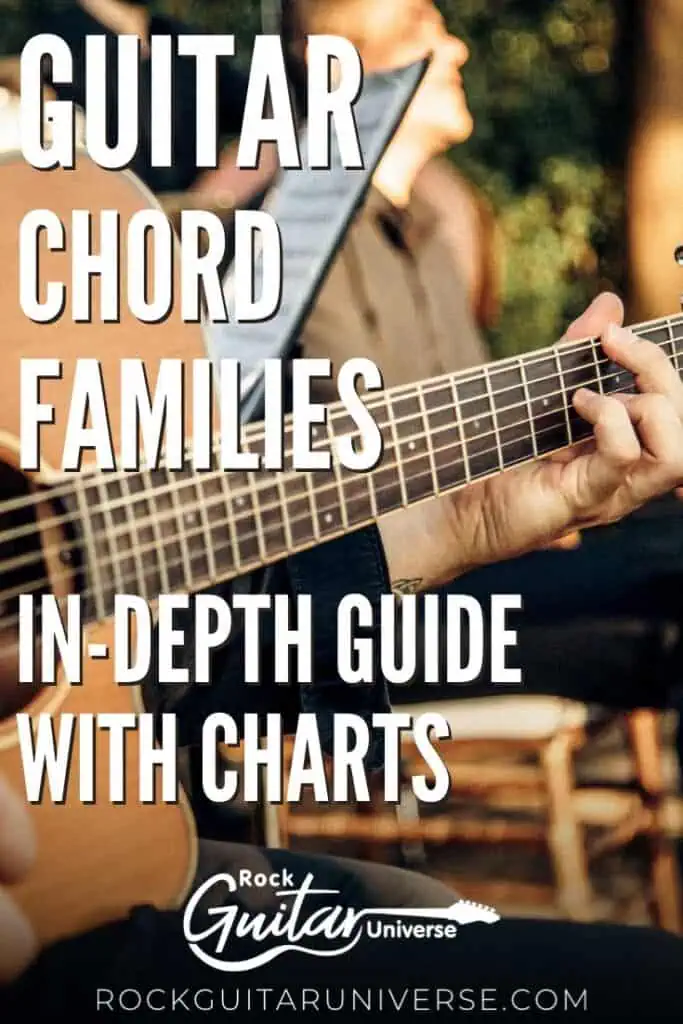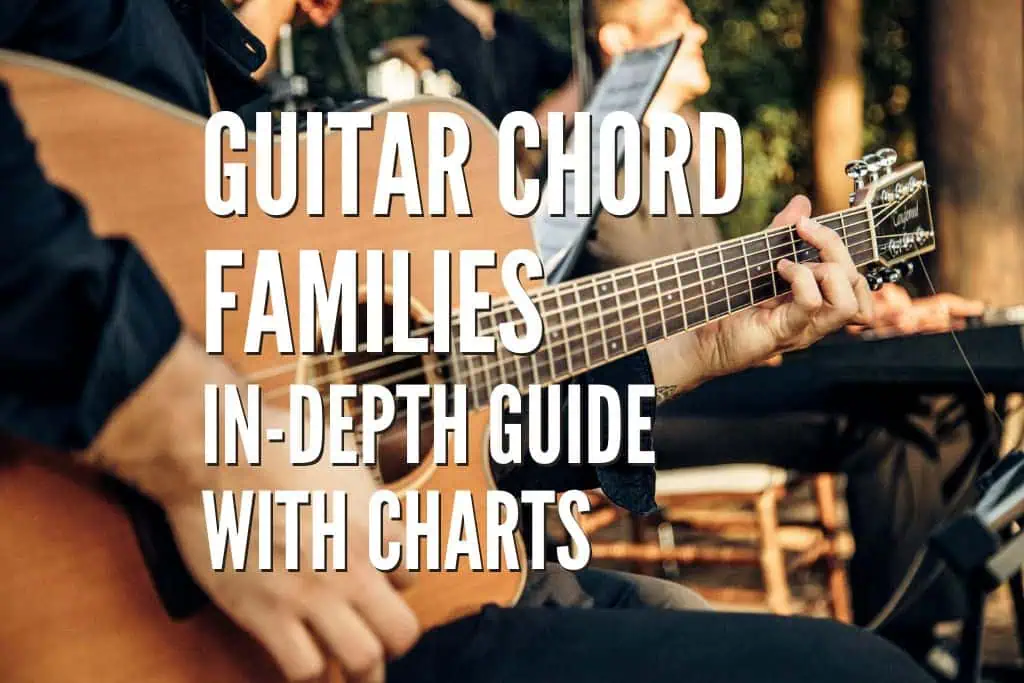When learning new songs have you noticed that some of the chord sequences sound really good? But when you tried to come up with your own chord sequence, or as we call it chord progression, you found yourself lost with the amount of possibility and weren’t sure if it only sounds good to you. This brings us to the theoretical topic in music theory of chord families.
So, what are chord families? Simply put, they’re groups of chords in a specific key (C major for example). While technically any chord can follow another, chord family theory talks about the right combinations that just feel right to the ear.
By staying within a chord family, your progressions will sound more cohesive because all the chords share the same scale. And since there are twelve notes in the chromatic scale, each mode gives us twelve unique chord families to work with.
Different Types Of Chords In The Family
One of the most common mistakes is to assume that all the chords in the major scale are major ones. Even though the scale is major, the chords from that family won’t be the same. There are three basic types of chords in each family and they are a major, a minor, and a diminished chord.
If we take a look at the C major scale, we will have C, D, E, F, G, A, B, and C which is one octave higher. The chords from this scale will be major, minor, minor, major, major, minor, and diminished. This can be applied for any other of the twelve notes from the scale.

Here are all the chord families for the major scale

Now, we will continue with the C major scale. The first note of the scale is C, as we already know, and it is the root note. But when we talk about chord families, C major is tonic. If we talk about the F chord family, the tonic would be F major, of course, for the major scale.
The role of the tonic is rather important since it will create a tonal center of the entire song. We already mentioned principle chords when we said that the families are based upon them in harmony. The first one is the root or the tonic chord. The second one is the fourth step or F major, and the last one is the fifth step or G major.
This topic maybe to theoretical for you, so you can check some easy chord progressions you can use right away 12 Simple & Easy Guitar Chord Progressions For Beginners
One of the important things you need to know is how to read chord families. We use Roman numerals for marking chords in the scale, and we will use capital letters for major chords, while non-capital letters will be for the minor.
So in the example of the C major scale, the I, IV, V is C, F, G, where all three chords are major. We already mentioned that the first one is tonic, the second one is subdominant, and the third one is dominant. These three are the main harmonic family.
Interestingly, these three chords are all major chords in the scale.
What Is The Role Of Each Chord?
The first one is the tonic. The role it is marked by the Roman numeral I and it is a major chord. Of course, all of this applies only for this scale and this mode, but more on that later. The role of the tonic is to create an atmosphere of the music piece. The whole point of musical creation is to create some kind of tension, and then to resolve it. This is achieved by returning to the tonic after some kind of progression. Usually, the tonic will be used to start and to end a composition or at least part of it.
The second one, or the sub-dominant, is marked by IV and it is also the major chord. The role of the sub-dominant is to transfer you away from the tonic and toward the dominant chord.
Finally, the last important bit of the family is the dominant chord which is the fifth chord in the family marked by V and in the example of C major it is G major chord. The dominant family wants to return you back to the tonic and create a circle. If played in sequence, the dominant will create a rather strong resolution to your chord progression.
Chord Families Modes
There are seven modes. So let’s start from the beginning.
Ionian Mode
As we already mentioned all of the previous examples can apply only to the major scale and there are twelve chord families. However, the major scale is just one of the modes available to you.
If we take a look at the C major scale, we have seven different notes C, D, E, F, G, A, B, C. Each of the major scales are built the same way. We have the root of C, full step to D, full step to E, half a step to F, full step to G, full step to A, half a step to B, and full step to C again.
So the schematics to create any major scale are F, F, H, F, F, F, H, F. Where F means full step, and H means half a step. This major scale is also known as the Ionian mode or the first mode where we will start everything. We already mentioned that we can build triads out of each of the chords where the first triad is tonic, the second one is called supertonic, the third one is mediant, the fourth one (we mentioned) is subdominant, the fifth one is dominant (also mentioned), the sixth one is submediant, the seventh one is leading tone, and the last one is tonic again.
If you want to check out more practical chord progressions, check out my post 24 Guitar Chord Progression You Must Learn (Common, Rock, Sad, Jazz)
Dorian Mode
If we take the same schematic, but move everything circular we will get F, H, F, F, F, H, F, F, where we just took the first full step and moved it to the end of the line, we will get the second mode or Dorian mode. So, for our dear C scale, Dorian mode would go like this C, D, bE, F, G, A, bB, C. While Ionian mode is a major one, also known as the major scale, Dorian is minor.
Naturally, we will get another twelve families of chords based on this mode where we would have different sounding chords and a different approach to the topic we already mentioned.
The chords in Dorian mode are like this i, ii, III, IV, v, vi⁰, VII. The first chord is minor, the second one is also minor, the third and fourth are major, the fifth one is minor, the sixth is diminished, and the seventh one is major. As you can see, everything is changed, and the whole scale will be a minor one just because we changed the order of the full steps and half steps. We already know the C major scale and the reason we use it always is that there are no half-steps on the scale. If you would play this on a piano, you would play only white keys starting from C. However, when it comes to the Dorian scale, D Dorian would go like this D, E, F, G, A, B, C, D.
Phrygian Mode
Let’s go a step further and move everything for one more space. We will have now H, F, F, F, H, F, F, F. This is the third mode and it’s called Phrygian Mode. In the example of C major, we will get C, bD, bE, F, G, bA, bB, C. As you might have guessed already, the perfect scale for the Phrygian mode is E Phrygian where the notes are E, F, G, A, B, C, D, E. Phrygian mode is also minor but you can use it for both minor and major scales. But let’s not complicate things further. The chords in the Phrygian family are i, II, III, iv, v⁰, VI, VII. This way you can build the Phrygian family of chords for any of the twelve notes of the chromatic scale.
Lydian Mode
Lydian is the fourth mode and if we continue moving notes from the scale (or starting point) we will get F, F, F, H, F, F, H. Lydian mode is a major mode, and in the example of C, the Lydian scale would go like this C, D, E, F#, G, A, B, C. The best scale for Lydian mode is, of course, F Lydian where notes are F, G, A, B, C, D, E, F.
Finally, the chord family for the Lydian scale is I, II, iii, iv⁰, V, vi, vii. Lydian mode is also major.
Mixolydian Mode
The fifth mode is Mixolydian and it is played from G to G using only white keys on the piano. Similarly to the previous examples, the notes for G Mixolydian are G, A, B, C, D, E, F, G. The schematic used for this mode is F, F, H, F, F, H, F, and if we apply this to C scale, we will get, C, D, E, F, G, A, bB, C. Naturally, like in the previous examples you could build twelve different chord families using the following scheme I, ii, iii⁰, IV, v, vi, VII. Mixolydian mode is a major one.
Aeolian Mode
Now, for this mode, things get a bit easier since this is our standard minor scale. As you might already know the minor scale for A is without any semi notes and it goes like this A, B, C, D, E, F, G, H, which is also known as a natural minor scale. If we apply this to C to create Aeolian mode we will get C, D, bE, F, G, H, bA, bB, C which is simply C minor scale. The scale is built with pattern F, H, F, F, H, F, F.
Naturally, you will have twelve more chord families that are built like this i, ii⁰, III, iv, v, VI, VII. And these are the chord families for the natural minor scale. This is one of the most popular modes besides the Ionian one since most of the songs are either in the major or minor key.
Here are all the chord families for the minor scale

Locrian Mode
Finally, we have the last mode or the seventh mode which is Locrian. The pattern for Locrian mode is H, F, F, H, F, F, F, and in the example of C we will have C, bD, bE, F, bG, bA, bB, C. Of course, we will have a B Locrian scale which will have only full notes and it will go like this B, C, D, E, F, G, H, A.
As in the previous examples, we will get our final twelve chord families for Locrian mode in the form of i⁰, II, iii, iv, V, VI, vii.
The Circle Of Fifths

While it might seem complex a bit, the basics are simple. Each of the modes will give us twelve chord families we could build and use. There are seven modes and twelve chords which gives us eighty-four different chord families, which is why you might sometimes feel confused when trying to remember them.
We can always place these modes in three groups where we will have three major modes Ionian, Lydian, and Mixolydian. And we will have three minor modes which are Dorian, Phrygian, Aeolian. The last mode or Locrian is diminished.
By knowing this, you could create additional six tables similar to the Ionian we created in the first example, this way, you will have all of the chords families for each of the chords in the chromatic scale in each of the seven modes.
Interestingly, what you’ll create by using this is also known as the circle of fifths which originated in the 17th century and explains the relationship between each of the notes in the chromatic scale.
Conclusion
It is worth mentioning that standard chord progressions are built mostly around the major scale or Ionian mode and using the same chords over and over again can get a bit boring, so you could always try experimenting to create something unique and interesting. Furthermore, the rules are meant to be broken and there are so many musicians that stepped out of these rules to create something beautiful and inspiring.
There are a few additional rules that might explain how to use other types of chords since we mentioned here are only minor, major, and diminished ones. As you know, there are so many songs that use suspended chords, augmented, sevenths, thirteenths, ninths, and so much more. But then things would get complicated even more than they are now.
If you found this article useful, you may want to save this pin below to your Guitar board.

4 thoughts on “Guitar Chord Families – In-Depth Guide With Charts”
Leave a Reply
Recent Posts
Some guitarists insist on buying an expensive amplifier with their electric guitar. They assume that this is a must for every type of guitarist out there. However, in some situations, this isn’t...
Top 50 Free Realistic Guitar VST Plugins With Sound Examples
As technology has rapidly advanced in the recent decade, computers are stealing more and more roles from physical musical instruments and accessories. Nowadays, you do not need expensive amps,...


I love this very simple and concise
Thanks, glad you loved it 🙂
Great content, short & to the point. Like the work 👍
Thanks, JJ
appreciate your support!